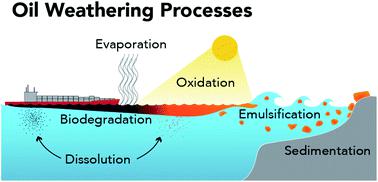当前位置:
X-MOL 学术
›
Environ. Sci.: Processes Impacts
›
论文详情
Our official English website, www.x-mol.net, welcomes your feedback! (Note: you will need to create a separate account there.)
How the 2010 Deepwater Horizon spill reshaped our understanding of crude oil photochemical weathering at sea: a past, present, and future perspective.
Environmental Science: Processes & Impacts ( IF 5.5 ) Pub Date : 2020-03-23 , DOI: 10.1039/d0em00027b Collin P Ward 1 , Edward B Overton
Environmental Science: Processes & Impacts ( IF 5.5 ) Pub Date : 2020-03-23 , DOI: 10.1039/d0em00027b Collin P Ward 1 , Edward B Overton
Affiliation

|
The weathering of crude oil at sea has been researched for nearly half a century. However, there have been relatively few opportunities to validate laboratory-based predictions about the rates, relative importance, and controls of oil weathering processes (e.g., evaporation, photo-oxidation, and emulsification) under natural field conditions. The 2010 Deepwater Horizon (DWH) spill in the Gulf of Mexico provided the oil spill science community with a unique opportunity to evaluate our laboratory-based predictions in nature. With a focus on photochemical weathering, we review what we knew prior to the DWH spill, what we learned from the DWH spill, and what priority gaps in knowledge remain. Three key findings from the DWH spill are discussed. First, the rate and extent of photochemical weathering was much greater for the floating surface oil than expected based on early conceptual models of oil weathering. Second, indirect photochemical processes played a major role in the partial oxidation of the floating surface oil. Third, the extensive and rapid changes to the physical and chemical properties of oil by sunlight may influence oil fate, transport, and the selection of response tools. This review also highlights findings and predictions about photochemical weathering of oil from several decades ago that appear to have escaped the broader scientific narrative and ultimately proved true for the DWH spill. By focusing on these early predictions and synthesizing the numerous findings from the DWH spill, we expect this review will better prepare the oil spill science community to respond to the next big spill in the ocean.
中文翻译:

2010年Deepwater Horizon溢油如何重塑了我们对海上原油光化学风化的理解:过去,现在和未来。
海上原油的风化已经研究了近半个世纪。但是,很少有机会验证基于实验室的关于油的风化过程的速率,相对重要性和控制的预测(例如,蒸发,光氧化和乳化)。2010年墨西哥湾深水地平线(DWH)泄漏为漏油科学界提供了一个难得的机会,可以评估我们基于实验室的自然预测。着眼于光化学风化,我们回顾了在DWH泄漏之前我们了解的知识,从DWH泄漏中学到的知识以及仍然存在哪些优先知识缺口。讨论了DWH泄漏的三个主要发现。首先,浮油表面油的光化学风化速率和程度远大于基于早期油风化概念模型的预期。其次,间接的光化学过程在浮动表面油的部分氧化中起主要作用。第三,阳光对油的物理和化学性质的广泛而迅速的变化可能会影响油的命运,运输和响应工具的选择。这篇评论还重点介绍了几十年前关于光化学风化石油的发现和预测,这些发现和预测似乎逃脱了更广泛的科学叙述,并最终证明对DWH泄漏是正确的。通过关注这些早期的预测并综合DWH溢油的众多发现,我们希望这次审查将更好地为溢油科学界做好准备,以应对海洋中的下一次大溢油事故。这篇评论还重点介绍了几十年前关于光化学风化石油的发现和预测,这些发现和预测似乎逃脱了更广泛的科学叙述,并最终证明对DWH泄漏是正确的。通过关注这些早期的预测并综合DWH溢油的众多发现,我们希望这次审查将更好地为溢油科学界做好准备,以应对海洋中的下一次大溢油事故。这篇评论还重点介绍了几十年前关于光化学风化石油的发现和预测,这些发现和预测似乎逃脱了更广泛的科学叙述,并最终证明对DWH泄漏是正确的。通过关注这些早期的预测并综合DWH溢油的众多发现,我们希望这次审查将更好地为溢油科学界做好准备,以应对海洋中的下一次大溢油事故。
更新日期:2020-03-23
中文翻译:

2010年Deepwater Horizon溢油如何重塑了我们对海上原油光化学风化的理解:过去,现在和未来。
海上原油的风化已经研究了近半个世纪。但是,很少有机会验证基于实验室的关于油的风化过程的速率,相对重要性和控制的预测(例如,蒸发,光氧化和乳化)。2010年墨西哥湾深水地平线(DWH)泄漏为漏油科学界提供了一个难得的机会,可以评估我们基于实验室的自然预测。着眼于光化学风化,我们回顾了在DWH泄漏之前我们了解的知识,从DWH泄漏中学到的知识以及仍然存在哪些优先知识缺口。讨论了DWH泄漏的三个主要发现。首先,浮油表面油的光化学风化速率和程度远大于基于早期油风化概念模型的预期。其次,间接的光化学过程在浮动表面油的部分氧化中起主要作用。第三,阳光对油的物理和化学性质的广泛而迅速的变化可能会影响油的命运,运输和响应工具的选择。这篇评论还重点介绍了几十年前关于光化学风化石油的发现和预测,这些发现和预测似乎逃脱了更广泛的科学叙述,并最终证明对DWH泄漏是正确的。通过关注这些早期的预测并综合DWH溢油的众多发现,我们希望这次审查将更好地为溢油科学界做好准备,以应对海洋中的下一次大溢油事故。这篇评论还重点介绍了几十年前关于光化学风化石油的发现和预测,这些发现和预测似乎逃脱了更广泛的科学叙述,并最终证明对DWH泄漏是正确的。通过关注这些早期的预测并综合DWH溢油的众多发现,我们希望这次审查将更好地为溢油科学界做好准备,以应对海洋中的下一次大溢油事故。这篇评论还重点介绍了几十年前关于光化学风化石油的发现和预测,这些发现和预测似乎逃脱了更广泛的科学叙述,并最终证明对DWH泄漏是正确的。通过关注这些早期的预测并综合DWH溢油的众多发现,我们希望这次审查将更好地为溢油科学界做好准备,以应对海洋中的下一次大溢油事故。



























 京公网安备 11010802027423号
京公网安备 11010802027423号